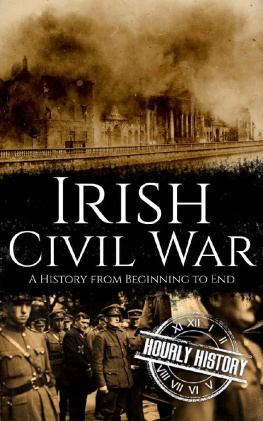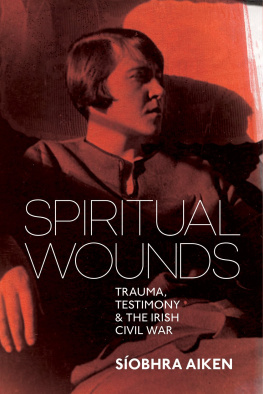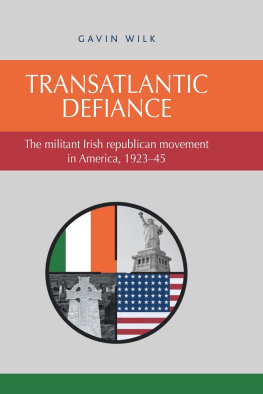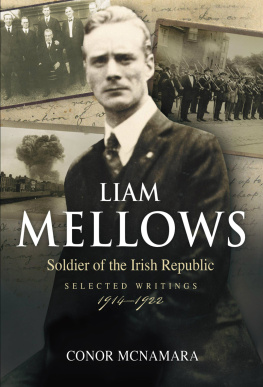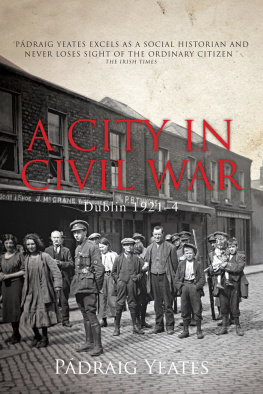THE IRISH CIVIL WAR
For Ethan, Isabel, Duncan and Marguerite
Sen Enright was called to the Bar at Middle Temple in 1982 and at the Four Courts in 1993. He practised at the Bar in London for many years and is now a Circuit Judge. He is the author of The Trial of Civilians by Military Courts: Ireland 1921 (Irish Academic Press, 2012) and Easter Rising 1916: The Trials (Merrion Press, 2014) and After the Rising: Soldiers, Lawyers and Trials of the Irish Revolution (Merrion Press, 2016).
THE IRISH CIVIL WAR
LAW, EXECUTION AND ATROCITY
Sen Enright
First published in 2019 by
Merrion Press
An imprint of Irish Academic Press
10 Georges Street
Newbridge
Co. Kildare
Ireland
www.merrionpress.ie
Sen Enright, 2019
9781785372537 (Paper)
9781785372544 (Kindle)
9781785372551 (Epub)
9781785372568 (PDF)
British Library Cataloguing in Publication Data
An entry can be found on request
Library of Congress Cataloging in Publication Data
An entry can be found on request
All rights reserved. Without limiting the rights under copyright reserved alone, no part of this publication may be reproduced, stored in or introduced into a retrieval system, or transmitted, in any form or by any means (electronic, mechanical, photocopying, recording or otherwise) without the prior written permission of both the copyright owner and the above publisher of this book.
Typeset in Minion Pro 11/14 pt
Cover front: Richard Mulcahy (left) and Chief of Staff Sean Mac Mahon (right) inspecting the new national army, autumn 1922. (Courtesy of IMA)
Cover back: National army troops fighting near Nelsons Pillar, June 1922. (Courtesy of NLI)
Contents
Acknowledgements
I acknowledge the patience and support of my wife Lorna. Also, the Master and Fellows of Sidney Sussex where I was a visiting scholar: the facilities and library of the College made this book possible. In particular, I acknowledge the encouragement of Professor Eugenio Biagini.
I also acknowledge and thank Hugh Beckett of the Irish Military Archives and the kind assistance of the staff at the National Library of Ireland, the National Archives of Ireland and the United Kingdom and the library staff at Stamford, Middle Temple and the British Library. Also, a special thank you to Aoife Torpey at Kilmainham Gaol Museum for generous assistance with photographs.
My thanks also to Tom and Aideen Carroll for on-the-spot help in Dublin; Tim Horgan for a tour of the cliffs overlooking the Clashmealcon caves in Kerry and help with Ballyseedy; and Stephen Kelleghan for help with Cahersiveen. Also help from Sen Hogan (Tipperary), Fr J.J. Rordin from Kiskeam and Michael Byrne of the Offaly Historical and Archaeological Society in respect of the executions of Cunningham, Kelly and Conroy. My thanks to Ian Kenneally (Athlone) in respect of Tony Lawlor and Tom Toomey from County Limerick. Pat McCarthy in Waterford for help with the executions of Fitzgerald and OReilly and Kieran Glennon in respect of the Drumboe executions. A special mention for John Dorney who gave assistance in respect of James ORourke, Grealy and Burke. To Maura OCronin and Dr John Cunningham from NUI Galway, Meda Ryan from west Cork and Peter Beirne of Clare County Library in respect of the Ennis executions. Also, Tommy Mahony from Kerry, Eoin Walsh in Kilkenny and Ellen D. Murphy for help generously given. A big thank you also to Amelia OConnor, Davide Corbino, Charles Falk, Christian Jowett and Al Smith.
I acknowledge permission to use photographs given by the Irish Military Archives, National Library of Ireland and Kilmainham Gaol Museum.
Mistakes and omissions are my responsibility.
Key Events and
Main Protagonists
The Key Events
July 1921 . The Truce between Britain and Ireland came into effect and brought the War of Independence to an end.
December 1921 . The Treaty was signed at Westminster. The contentious parts of the Treaty allowed the creation of an Irish Free State under the sovereignty of the British monarch and permitted the Unionist majority in Ulster the opportunity of opting out of the new state.
7 January 1922 . After lengthy and bitter debate the Treaty was approved by the Dil by a margin of 6457. A provisional government was formed to govern until the Irish Free State could be brought into being.
The anti-Treaty Executive took over the Four Courts and plans were made to launch an attack on units of the British Army not yet evacuated and bounce the provisional government into a resumption of the war between Britain and Ireland.
16 June 1922 . The general election in which the Treaty was the dominant issue. Fifty-eight pro-Treaty Sinn Fin candidates were returned and thirty-six anti-Treaty. Most of the other elected deputies were broadly pro-Treaty.
22 June 1922 . The assassination of Sir Henry Wilson in London by London-based IRA men. The government of Lloyd George blamed the anti-Treaty faction that had taken over the Four Courts and briefly considered direct military action.
28 June 1922 . The National Army of the provisional government bombarded the Four Courts and the civil war began.
August 1922 . The death of President Griffith and Michael Collins, Commander in Chief of the National Army.
28 September 1922 . The Dil passes the Army (Special Powers) Resolution creating military courts with the power to impose the death penalty for possession of arms and other specified offences.
17 November 1922 . The first executions.
6 December 1922 . The Irish Free State came into being. As expected, the Six Counties in the North opted out.
8 December 1922 . The Mountjoy executions. Four anti-Treaty prisoners were executed without trial as a reprisal for the murder of Sean Hales TD.
10 April 1923 . The death of Liam Lynch, Chief of Staff of the anti-Treaty faction. This effectively brought about the end of the civil war.
27 April 1923 . Ceasefire order issued by Frank Aiken, the new Chief of Staff of the anti-Treaty faction to take effect in seventy-two hours.
24 May 1923 . Dump arms order issued by Frank Aiken, Chief of Staff of the anti-Treaty faction.
2 June 1923 . The last executions. In total eighty-three men were executed by firing squad.
The Factions
Pro-Treaty: this faction favoured the Treaty between Britain and Ireland. After the Dil adopted the Treaty, their leaders formed a transitional administration known as the provisional government that lasted until the creation of the Irish Free State which took place on 6 December 1922. Where possible they are referred to in this work as the provisional government or pro-Treaty and after 6 December 1922 as the government of the Irish Free State.
Anti-Treaty: this faction was composed of those opposed to the Treaty terms agreed between Britain and the Dil. This faction favoured complete independence from Britain and the Commonwealth and were opposed to the partition of Ireland. During the civil war this faction was variously known as the IRA, Irregulars or Irreconcilables. Anti-Treaty is a neutral term and that is how they are generally referred to in this work.
The Leaders
Michael Collins was a signatory of the Treaty and head of the IRB. He was commander in chief of the National Army and the de facto head of civilian government. He was killed in action in August 1922.
Liam Cosgrave had been a long-time member of the Dublin Corporation where he did much to alleviate poverty in the city. He was a junior officer in the Irish Volunteers in 1916. After the rebellion he was tried and narrowly escaped execution. During the War of Independence, he was minister for local government. He was a grocer by trade before his involvement in politics. A slightly built man with a big quiff and a fondness for morning dress. He became head of the provisional government after the death of Arthur Griffith and Michael Collins. Few thought Cosgrave had the mettle to lead the pro-Treaty faction through the civil war.


